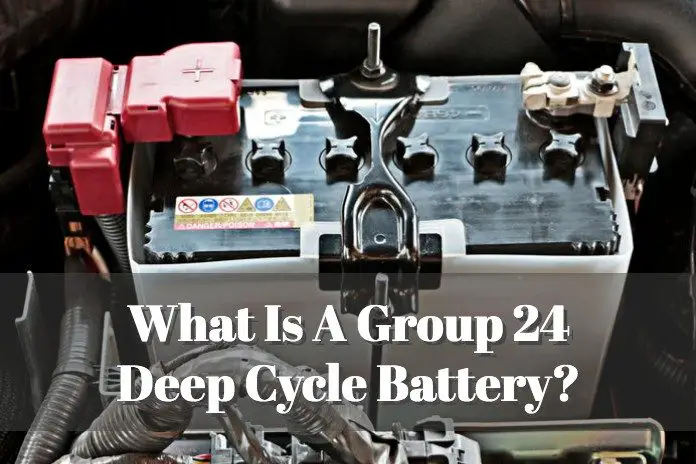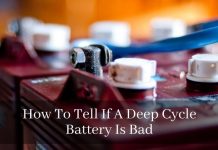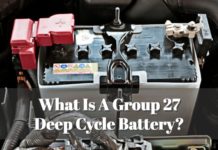
Whenever you turn over the battery of your car, you’ll find letters and numbers written. Surprisingly, most people don’t take their time to research what the numbers mean. They see them not necessary until it’s time to renew the battery. When looking for a new battery to install in the car or boat, you will need a detailed description of the cell, and that means the numbers you find on the side.
Now and then, I’ve come across drivers asking what groups 24 deep cycle batteries are really? Group 24 deep cycle batteries are simply batteries ranked size number 24 as per the Battery Council International (BCI). The council usually assigns numbers plus letters based on the cell’s size and descriptions.
Understanding these groups, group 24, especially, is essential as the batteries in this group are common. Group 24 batteries are usually 10.3” long, 6.8 inches wide and 8.9 inches high. Knowing the group of your battery ensures that you see the size you want for your power needs.
BCI tries to minimize the changes in the chart. However, changes can come, but with time. Therefore, if you’re new to the world of batteries and stuff, it’s advisable to confirm with your old battery, the size.
What Is A Group 24 Amp Hours?
The batteries in the group 24 deep cycle category are made to regularly get deeply discharged using most of their capacity. As compared to the batteries in group 27, for instance, group 24 batteries tend to have lower Amp-hours. The Amp differences are made on purpose by the different cell suppliers.
In other words, it means that the higher the group, the more the amp hours. However, this doesn’t mean that you’ll have to run out of power for owning a group 24 battery. For as long as the size matches your electric power needs, you’re set to go.
What Cell Should I Choose for My Watercraft?
Like it’s in cars, boats do as well need the power to run. The truth is that most boat owners don’t take their time to observe what type of batteries their boats use. They wait until the boat develops a glitch before they run into an auto shop looking for a replacement. When it comes to shopping for a new battery, it’s advisable to consider the specs.
In addition to the group, you should consider one with a letter ‘M’ on the description. Why the letter M, you may ask? The letter M here indicates that that specific battery is designed for watercraft use.
Watercraft batteries are designed for long runs, as the boat requires. Although an average battery may power the vessel, it may decline quickly. This means that using the conventional cells on the boat can see you have to pull over the dock now and then when it drags.
What Group 24 Deep Cycle Should I Consider?
1. Trojan SCS150
The Trojan SCS150 is one of the few flooded batteries you will find in group 24. The battery needs a bit of maintenance, as you must check its electrolyte levels now and then. It runs while positioned in a vertical position and must be in a well-ventilated area.
But, it’s an ideal kind of battery based on its lightweight nature (50 pounds). It can be a perfect choice where a pack of several batteries is needed.
The Trojan SCS150 comes with a marine cranking amp (MCA) of 650 amps. With 650 amps, it’s ideal for the basic boat functionalities. But, it’s advisable not to use it as a cranking battery as this may lower its lifespan. It is designed for low current applications (10 Amps and below). When discharged at over 25 Amps, its capacity reduces drastically.
2. Bass Pro XPS Power Series
If you don’t need that much cranking power, or you’re running a medium horsepower engine, then you can consider this dual-purpose battery. The Bass Pro XPS power series can save you a tremendous amount of cash. With a cold cranking amp (CCA) of 550 amps, this battery goes for around $150. The cell has a RC of 120 minutes, under a 25 amps discharge rate.
As a deep cycle battery, this brand is built to sustain the repeated deep discharge and is quick to recharge. The battery comes with an AGM construction and thus resistant to vibration. The design boosts its lifespan, while its dual terminal makes the installation process easy.
It weighs 43.5 pounds with a size of 6.75” by 9.37” by 10.75”. Whenever you buy the battery, you’re guaranteed a 3-year pro-rated marine battery warranty and a one-year free replacement.
3. VMAX MR96-60 AGM
The VMAX MR96-60 AGM is a high-performance 12-volt battery with a float service of 8-10 years. The battery’s construction is unique and what makes it a durable choice. It comes with military-grade plates, which enhances its performance even after several times of regular discharges.
It’s a maintenance-free battery, and that means you won’t have to add water now and then, during service life. The cell contains a perfect electrolyte system and AGM construction, which ensures that the electrolyte is held in place and used to the maximum.
4. Universal Power Group UB12750 458211
This battery is an ideal wheelchair mobility deep cycle battery measuring 10.24 inches by 6.61 inches by 9.13 inches. It weighs 49.10 Lbs., and that means that it can be mounted on any position within the scooter.
It’s AGM/SLA, and that means that it’s resistant to spills if an accident occurs. Its design makes it resistant to vibrations and shocks. This battery from Universal Power Group comes with a one-year warranty.
5. Weize
Number five in the list of best group 24 deep cycle batteries is Weize. The battery by Weize is 12 volts. It measures 12.09 x 6.65 x 8.94 inches. It’s designed specifically for use EVs, golf carts, scooters, wheelchair, medical equipment, hunting, and garden tools. It’s sealed, and that means no maintenance needed.
The battery can sustain the regular deep discharging without failing. It’s ideal for individuals who need a high-performance battery with a long lifespan. When you buy this model, you’re guaranteed a one-year warranty and a 30-days refund if the battery fails.
What Are The Pros and Cons of Using Group 24 Deep Cycle Batteries?
Pros:
• The batteries in group 24 last long
• The batteries’ deep cycle nature makes them dependable
• Their design and construction enhance the battery for tough situations
• The batteries are light in weight as compared to the other groups
• They are easy to install
Cons:
• A bit complicated to understand





